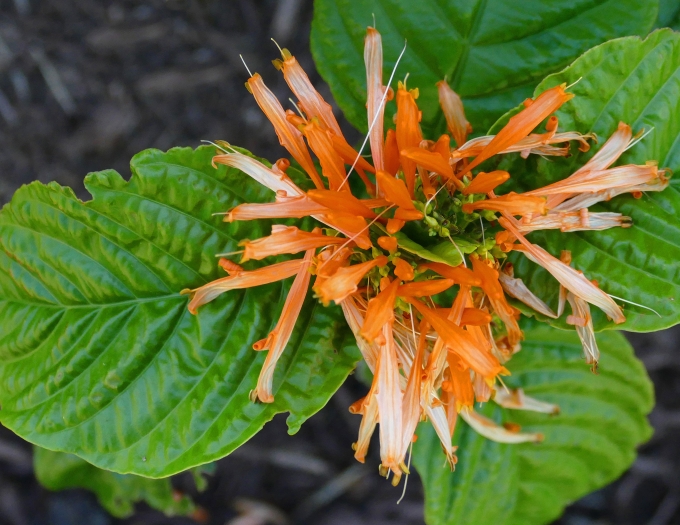Mexican Honeysuckle
(Justicia spicigera)
Mexican Honeysuckle (Justicia spicigera)
/
/

Jim Evans
CC BY-SA 4.0
Image By:
Jim Evans
Recorded By:
Copyright:
CC BY-SA 4.0
Copyright Notice:
Photo by: Jim Evans | License Type: CC BY-SA 4.0 | License URL: https://creativecommons.org/licenses/by-sa/4.0 | Uploader: Jim Evans | Publisher: Wikimedia Commons | Title: Mexican_honeysuckle_--_Justicia_spicigera.jpg | Notes: {{Information |Description=Weathered ''[[Pinus contorta]]'' subsp. ''murrayana''. Lassen Volcanic National Park, Tehama County, California. |Source=[http://www.flickr.com/photos/96463101@N00/2739858668/ Weathered pine] |Date=2008-08-04 15:48 |Autho











































Estimated Native Range
Summary
Justicia spicigera, commonly known as Mexican Honeysuckle, is an evergreen perennial herb native to open woodlands and forest edges in Mexico and Central America. It thrives in a warm climate and can reach heights of 2–5 feet with a similar spread. The plant has a bushy habit with elliptical leaves that are typically around 2 inches long. Its tubular, bright orange flowers bloom throughout the year in its native range, attracting hummingbirds and providing a continuous display of color. The flowers are particularly showy, making it a favorite among gardeners for its ornamental value.
Mexican Honeysuckle is valued for its low maintenance requirements and adaptability to a range of light conditions, from full sun to partial shade. It is often used in border planting, as an informal hedge, or as a colorful accent in tropical and subtropical gardens. While it prefers warm weather, it can tolerate brief cold snaps down to about -3 °C (26 °F). In cultivation, it performs best in well-drained soils and requires low to medium amounts of water once established. The plant’s ability to produce a natural dye from its leaves, which can change color based on pH levels, is an interesting aspect for those interested in natural dyes. However, gardeners should be aware that Justicia spicigera can be susceptible to root rot if overwatered or planted in poorly drained soils.CC BY-SA 4.0
Mexican Honeysuckle is valued for its low maintenance requirements and adaptability to a range of light conditions, from full sun to partial shade. It is often used in border planting, as an informal hedge, or as a colorful accent in tropical and subtropical gardens. While it prefers warm weather, it can tolerate brief cold snaps down to about -3 °C (26 °F). In cultivation, it performs best in well-drained soils and requires low to medium amounts of water once established. The plant’s ability to produce a natural dye from its leaves, which can change color based on pH levels, is an interesting aspect for those interested in natural dyes. However, gardeners should be aware that Justicia spicigera can be susceptible to root rot if overwatered or planted in poorly drained soils.CC BY-SA 4.0
Plant Description
- Plant Type: Herb
- Height: 4-6 feet
- Width: 2-3.5 feet
- Growth Rate: Moderate
- Flower Color: Orange
- Flowering Season: Summer, Fall
- Leaf Retention: Evergreen
Growth Requirements
- Sun: Part Shade
- Water: Low, Medium
- Drainage: Fast
Common Uses
Bee Garden, Bird Garden, Butterfly Garden, Deer Resistant, Drought Tolerant, Fire Resistant, Hummingbird Garden, Low Maintenance, Potted Plant, Showy Flowers, Street Planting
Natural Habitat
native to open woodlands and forest edges in Mexico and Central America
Other Names
Common Names: Firecracker Bush , Orange Plume Flower , Mexican-Indigo , Moyotle , Moyotli , Mohintli , Muicle , Trompetilla , Yaxan , Ych-Kaan
Scientific Names: Justicia spicigera , Justicia scarlatina , Jacobinia spicigera , Jacobinia mohintlii , Sericographis mohintli , Jacobinia mohintli , Jacobinia neglecta , Jacobinia atramentaria , Jacobinia scarlatina , Justicia ghiesbreghtii
GBIF Accepted Name: Justicia spicigera Schltdl.